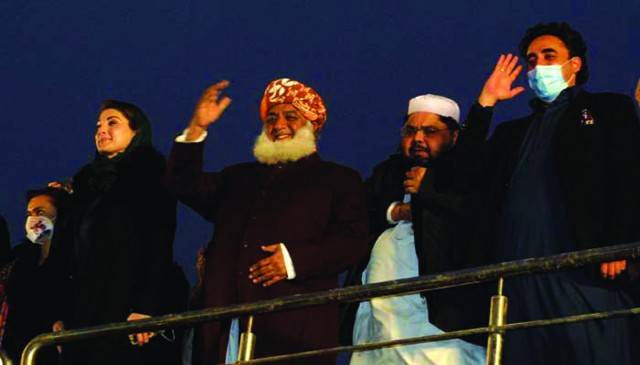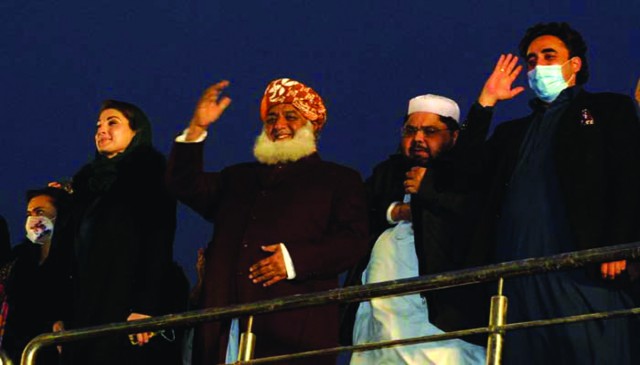
There is no doubt that PTI’s jalsas have become permanently embedded in the public imagination as some sort of benchmark of shows of strength; Imran Khan’s popularity and the emergence of a new political force attracted scores of people to the party’s public gatherings. Imran was not the first popular leader in Pakistan’s history to attract large crowds but to the young people who were politicized in this time, it seemed as if he was. This is because his message was amplified by the emergence of social media and as well as the extensive coverage provided by electronic media. Those who visited the PTI’s jalsas would speak of boundless energy at these events; the music played by DJ Butt would rejuvenate the masses and the content of Imran’s speeches would be hotly debated in newspapers and on talk shows.
Despite the chaos, the environment at the jalsa was electric. There were women, children and young people braving the cold as “Vote Ko Izzat Do” blared from the speakers
With this context, the pressure was on the Pakistan Muslim League-Nawaz when it began organizing for the PDM jalsa in Lahore. After all, Lahore is the home and seat of power of the Sharifs; their party holds 11 National Assembly seats here and most of its main heavyweights are from the city. In the lead up to the PDM jalsa in Lahore, the party mobilized not just its traditional support base through its MNAs and MPAs, but also reached out to civil society groups and invited them to include their demands and expectations in the PDM charter of demands. The party even deputed leaders to reach out to student groups; Rana Mashhood was spotted at Students Solidarity March on November 29, where he invited young leaders of the burgeoning student movement to join the jalsa on December 13 and promised that their demand for restoration of student unions would be taken up by the PDM leadership.

Senior journalist Nusrat Javed once commented that the success of the PML-N’s narrative has been that it has turned its voter into an activist. These first-time activists found themselves organizing their jalsa in a very hostile environment. A few days before the jalsa, DJ Butt was arrested when word came that he was being engaged by the party to provide a sound system for the demonstration. News of his arrest served as a deterrent for other vendors. A party worker told me that no one was willing to provide services after Butt’s arrest. “No one wanted to risk jail time and so we had to find someone from outside of Lahore to provide a sound system.” Party workers said because of the looming fears of FIRs and state repression, most logistics were finalized only 36 hours before the jalsa. “We didn’t have a container to set up stage till the night of December 12,” another party worker says. “No one was willing provide containers, as people were afraid that these would be seized by the government after the jalsa.”
Party workers also had trouble arranging chairs. “In the end we had to purchase chairs as we could not rent them and we had to buy them at exorbitant rates. If a brand-new chair is for Rs100, we purchased secondhand seats for Rs300.” The party acquired 18,000 chairs which were set up at the venue the night before the jalsa. On the day of the jalsa, however, these seats were not enough.
Party workers say that no traffic or security plan was devised by the government ahead of the jalsa. “Usually, the government shares a traffic plan with the public which earmarks alternative routes, parking spots and entry points to big demonstrations. This traffic plan is published in newspapers and shared with parties. A detailed security plan is also shared with leaders ahead of major events. Even though so many high-profile leaders were present at the jalsa on December 13, there was no security provided to them or the thousands of people in attendance. There was no police presence, nor was there any traffic plan.”
This scribe also attended the PDM jalsa in Lahore. While I was present at the jalsa, I was not aware of the coverage of the event on electronic media. Mobile phone signals were jammed in the area, which impeded access to social media and made it difficult for journalists to provide live visuals and share speeches with the public. These jammers also impeded functioning of drone cameras. “We knew that a jammer had been installed at the Minar itself the night before the jalsa; we watched its installation and we could not take it down because it was government property,” a party worker told me. “This jammer would not allow drones to fly beyond a certain distance and our range was severely restricted.”
When I returned, I was surprised to find that certain channels were reporting small numbers at the venue, saying the public was “lacking motivation.” My experience was exactly the opposite; I found the roads leading to the venue clogged with supporters and one had to walk a few kilometres to reach there. The gates, too, were filled with people. Gate number five had been earmarked for the general public and gate number four was cordoned off for the PDM leadership. Soon after the PDM leadership reached the venue, the distinction between these gates disappeared; supporters broke the barriers and closed in around the stage, filling the media gallery and the Minar. It was clear that the number of people who showed up at the jalsa were more than what the PML-N had prepared for; there was a stampede and some workers were injured. Lights and sounds also collapsed at certain moments as a result of the chaos around the stage.
Yet, despite the chaos, the environment at the jalsa was electric. There were women, children and young people braving the cold as “Vote Ko Izzat Do” blared from the speakers, and the venue was festooned with bright colors representing various political parties and their supporters who were in attendance. When a group of boys got too rowdy, JUI-F’s workers – easily distinguishable with their uniforms –suddenly appeared and broke up the fight. There was a roar of approval from the crowd when Nawaz Sharif was brought on screen the first time; as he smiled and waved, people cheered and waved back.
How big was the PDM Lahore jalsa? PML-N workers answer this question in simple terms: it was big enough for the party to demonstrate its strength in Lahore, and to convey the message that the city was still very much theirs. It was big enough for there to be a malicious disinformation campaign in the media against the event, and it was big enough to prompt the government to seek an early Senate election.
The writer is TFT News Editor and can be reached on Twitter @aimak

